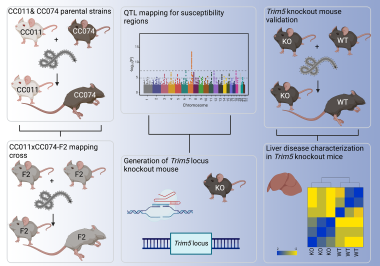Genetic discoveries in mice shed light on vulnerability to Ebola virus disease
May 10, 2024
The virus that causes Ebola virus disease (EVD) has seen rare but repeated outbreaks, particularly in African countries. While most outbreaks are limited, the risk of dying from contracting Ebola virus is around 50% on average, making any occurrence of the disease an urgent public health concern.
Data from other outbreaks, like SARS and COVID-19, have helped scientists understand the role that genetics play in susceptibility to viral infections. Researchers at UNC-Chapel Hill have been studying the effects of Ebola virus in a special breed of mice that shares similarities with humans in their viral response patterns and health outcomes.
In collaboration with researchers at the National Institutes of Health (NIH), this team of researchers have published a new study in Cell Reports identifying two specific genetic regions in these mice that are vulnerable to Ebola virus’ most deadly effects.
These genetic vulnerabilities, found in chromosomes eight and seven, are linked to high amounts of virus in the blood and severe inflammation, particularly in the liver.
“We know the liver is one of the principal target organs for Ebola virus infection,” said Alexandra Schaefer, PhD, who is assistant professor of epidemiology at the UNC Gillings School of Global Public Health. While the virus is transmitted by contact with infected bodily fluids, the liver becomes a dominant site for virus replication and inflammation. In some individuals, this overactive immune response can oftentimes be fatal. “The liver is pretty much where everything starts and ends with Ebola.”

Dr. Alexandra Schaefer

Dr. Ralph Baric
Schaefer co-authored the study along with epidemiologists, virologists and geneticists from across Carolina and NIH as part of ongoing research on Ebola led by the lab of Ralph S. Baric, PhD, William R. Kenan, Jr. Distinguished Professor in the Department of Epidemiology at the Gillings School and professor in the Department of Microbiology and Immunology at the UNC School of Medicine.
Baric noted that “Alex’s work has revealed an entirely new understanding of how Ebola virus causes lethal infections, providing new opportunities for diagnostics, therapeutic intervention and control.”
The lab has, for years, been seeking potential treatment strategies for dangerous viral threats by mapping how natural variation in host genes regulates disease severity in mammals using collaborative cross (CC) mice. These innovative mice were bred specifically to resemble the genetic diversity of humans in the hopes of mapping common mammalian genes that influence severe viral disease outcomes. By identifying these host genes, new strategies can be developed to counter disease severity.
In this new study, researchers found one host vulnerability in chromosome eight, which regulates viral load, or the amount of virus in the blood. Higher amounts of viral load typically indicate the progression of an infection.
The team also found a second host vulnerability in chromosome seven, where the presence of a functional genetic region (locus) called TRIM5 was linked to severe liver inflammation, weight loss and eventual death. In this instance, individuals with defective TRIM5 genes are protected from severe disease.
“TRIMs are innate immune genes,” Schaefer explained. “They have a big function in how cells respond to control virus infection and replication.”
Many TRIMs activate critical functions in the body that fight viral infections. However, the researchers found that in the case of Ebola virus infection, the presence of a functional TRIM5 locus actually led to worse outcomes and eventual death because the virus provoked an overactive immune response called a cytokine storm, causing massive cell death, inflammation and liver failure.
The genetic responses the lab observed in CC mice infected with Ebola virus were similar to genetic responses previously observed in those infected with the viruses that cause SARS (SARS-CoV) and COVID-19 (SARS-CoV-2). Such findings eventually played a role in the treatment and vaccine development of both diseases.
While very little data is currently available on the biomarkers that identify humans who could be susceptible to lethal Ebola infections, the research team is hopeful that these new results in mice will be similarly valuable in the quest to find effective treatment and prevention strategies.
Schaefer says that because so much of Ebola’s damage is concentrated in the liver, their next goal is to investigate the exact mechanism that TRIM5 genes use to cause liver failure and lethal disease.
“[TRIM5] is a protein that interacts with other proteins in cells to respond effectively to most viral infections. Ebola virus has figured out a strategy to use this basic host defense strategy and subvert it. Understanding the mechanism that drives disease,” she said, “will provide opportunities to do something about it.”
Contact the UNC Gillings School of Global Public Health communications team at sphcomm@unc.edu.

